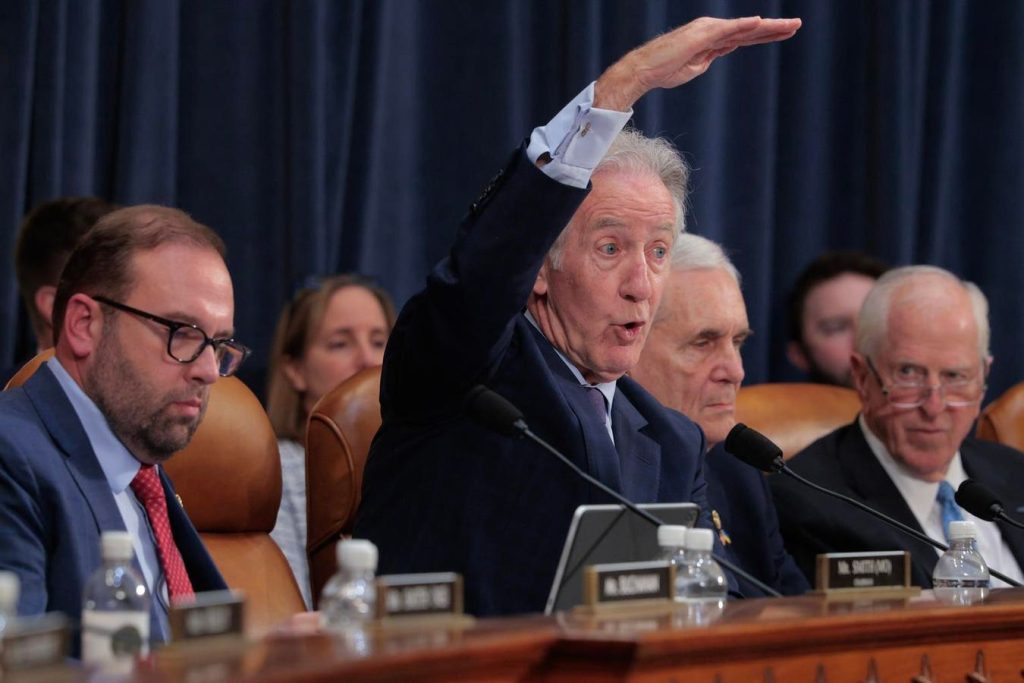WASHINGTON, DC – MAY 13: House Ways and Means Committee ranking member Rep. Richard Neal (D-MA) (C) … More
More than eight in ten households would get a tax cut in 2026 under the big budget bill now being considered by the House, according to a new analysis of the reconciliation bill by the Tax Policy Center. But 60 percent of the tax cuts would go to the top 20 percent of households and more than one-third would go to those making $460,000 or more, TPC found.
The average household would get a 2026 tax cut of about $2,900, compared to what it would pay if key provisions of the 2017 Tax Cuts and Jobs Act (TCJA) expire as scheduled at the end of this year. But the variation among income groups is striking, with upper-middle income households faring best on average and low-income households getting the smallest tax cuts, both in dollars and as a share of after-tax income.
The bill would reduce federal revenues by $3.8 trillion over the next decade, according to the congressional Joint Committee on Taxation. Some of that lost revenue would be offset by spending cuts, many of which would reduce government assistance to low-income households. Overall, the package would add $3.3 trillion to the federal debt over the next decade, the Committee for a Responsible Federal Budget estimates.
What TPC found
The lowest-income 20 percent of households, those making about $35,000 or less, would get a tax cut of less than 1 percent, or about $160 on average. Including the loss of some Affordable Care Act health insurance premium subsidies, their tax cut would fall to only about $60. Those making less than $20,000 would pay $40 more in taxes after losing their premium tax subsidies.
Middle-income households would receive an average tax cut of about $1,800, or about 2.4 percent of their after-tax income.
By contrast, households making between $460,000 and $1.1 million (the top 95th to 99th percent of income) would be the biggest beneficiaries. The bill would cut their taxes by an average of nearly $21,000, or 4.3 percent of their after-tax income.
In dollar terms, the biggest winners would be the top 0.1 percent of households, those making more than $5 million annually. Their taxes would decline by an average of almost $300,000, or about 3.3 percent of their after-tax income.
Within income groups, circumstances would significantly affect household taxes.
For example, about 17 percent of the top 1 percent of households (those making $1.1 million or more) and about 22 percent of those making $5 million or more would pay more in taxes than under current law, TPC found. In part this is due to limits on the ability of some pass-through businesses to fully deduct their state and local taxes and a limit on all deductions for top-bracket households.
Additionally, because the bill temporarily increases the child tax credit to $2,500 per child, families with children would receive even larger tax cuts than childless households making the same income. For example, a middle-income family with children would get an average tax cut of about $3,000, compared to $1,800 for all middle-income households.
By contrast, low-income older adults would get a tax cut of only $10 on average compared to the $160 noted above, while middle-income seniors would see their taxes decline about $1,100, about one-third less than that income group overall.
And even workers making exactly the same income would pay different taxes, depending on how they are compensated.
What the current bill does
The current bill, which has been narrowly approved by the House Budget Committee, is likely to be revised before it reaches the House floor. House Speaker Mike Johnson (R-LA) says he expects that vote later this week.
For now, the massive bill extends most individual tax provisions of the TCJA, including its higher standard deduction and child tax credit and lower tax rates for many. It continues and expands special tax benefits for some pass-through businesses such as partnerships and sole proprietorships, adds some business tax breaks, and includes a higher estate tax exemption.
At the request of President Trump, it makes tips and overtime tax free, at least temporarily, and allows consumers to deduct interest on auto loans. It increases the standard deduction by up to $4,000 for those for those age 65 and older and temporarily boosts the standard deduction for all non-itemizers.
At the same time, it caps itemized deductions for top-bracket taxpayers, limits tax benefits for certain immigrants, raises taxes on university endowments, and repeals a wide range of green energy tax subsidies that were adopted by Congress in 2023.
It should be no surprise that a bill that cuts taxes by $3.3 trillion over 10 years spreads its largesse across all income groups. But as TPC found with the original TCJA, this bill tilts heavily in favor of higher-income households.

